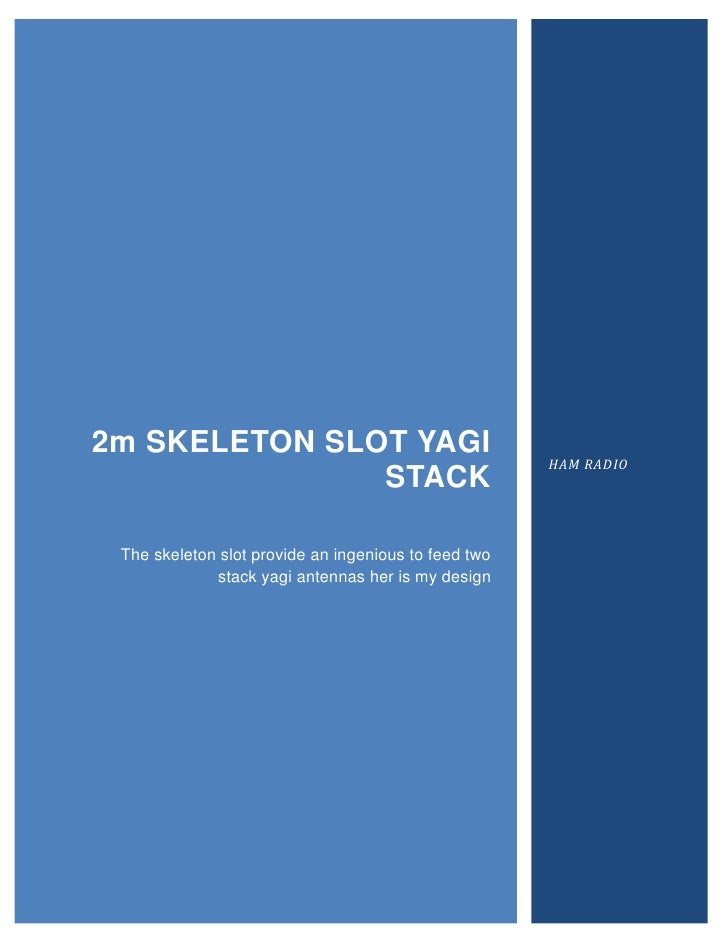2 Meter Skeleton Slot Antenna
Amazon's Choice for 2 meter antenna Dualband Mobile Antenna 2m/70cm VHF/UHF Ham Radio, 137-149, 437-480 Mhz, Magnet Base PL-259 Connector, 10 Ft RG58 Cable 4.4 out of 5 stars 284. 2:1 SWR: 9.93-10.24; This antenna exhibits better bandwidth than the 75/40 and even reaches an SWR of 1.1:1 on 30 meters. 40/20 Bandwidth. This antenna is by far the best design of the bunch. This configuration results in an SWR of under 2:1 across the entirety of both the 40 and 20 meter bands. Antenna Winders. The skeleton slot provide an ingenious to feed two stack yagi antennas her is my design. Post 14 Nov 2019. Build a 2 Meter, 5/4 Wave Antenna By Mike Martell, N1HFX. Skeleton Slot Antenna category is a curation of 4 web resources on, HF Skeleton Slot Antennas, HF Skeleton Slot, About Skeleton Slot Antenna. Resources listed under Skeleton Slot Antenna category belongs to Antennas main collection, and get reviewed and rated by amateur radio operators. I am contemplating a 40' vertical x 13' horizontal multi-band Skeleton Slot suspended from a 60' tree. Modeled after G3LDO's design in ARRL Compendium # should be a good, rotatable, bi-directional performer from 40 meters up to 6 meters with good gain on 20, 17, 15, 10 and 6.
- Events
HF Skeleton Slot - An antenna system with a difference.
For many years at this QTH I have tried different wire antennas. Not being interested in rotary beams of the usual type, I have always use fixed wire antennas.
Over the years I came to the conclusion that for my particular purposes I needed something with gain that would work in more than one direction.
Having tried vertical beams and phased verticals all hanging from a nylon line, I decided to use the same nylon line to hold up a Lazy H antenna.
The Lazy H works very well of course, Bi-directional, low angle and gain, BUT its a bit too big to rotate to fill in the directions 90° from its broadside line of fire and I don't have the room to put up a second Lazy H.
It was while playing around with this antenna using the MMANA-GAL modeling program that I tried bending the ends of the top dipole down and the ends of the bottom dipole up, still keeping the open wire phasing line between the two dipoles and fed in the center. I eventually ended up with the ends of the dipoles joined together and the horizontal top and bottom parts of the dipoles very much shortened and tried feeding at the junction of the dipole ends, getting rid of the phasing line between the two dipoles.
This arrangement now reminded me of the VHF skeleton slot antenna that I had seen in an old RSGB handbook, but a search on the Internet turned up nothing for an HF version.
More adjustments in the MMANA-GAL program showed that the antenna should perform well on all bands from 30 meters to 10 meters.
To get the low angle take off, the bottom of the antenna needs to be about 15 feet (4.5M) off the ground. It will still work if the bottom is lower but with a higher angle of take off.
I purchased a Pump up mast 50 feet (15m) and a small cord operated rotator. The top horizontal spreader is fixed to this rotator and the whole antenna hangs down from there.
The MMANA-GAL program can be found here.
Below are the dimensions I used for the Lazy-H antenna.
The plot below shows the gain and angle of elevation of the Lazy-H, as computed with MMANA-GAL. The antenna works well but is difficult to rotate.
The photograph below shows the antenna installed at my QTH.
Hf Skeleton Slot Antenna
The top spreader is 50 feet above ground. The bottom about 20 feet above ground level.
HF Skeleton slot
The drawing above shows the dimensions of my Skeleton Slot.
It can be easily rotated. It is bi-directional. It has high gain, low angle of elevation, and can work on all bands from 10 to 30 MHz.

Below are the plots of the Slot for the bands 20m, 17m, 15m and 10m.
Below is shown a 'BowTie' version.
It has slightly higher gain and lower angle of elevation.
The corresponding plots are shown below.
This picture shows the bowtie version at GW3RQT(SK)'s
The small marine ply support for the spreaders can be seen in the center.
The short horizontal bamboo in the center is to support the dog bone insulator and the open line feeder together with the vertical wires coming from the four corners.
Alan GW3RQT(SK) uses the same antenna but with smaller dimensions as his mast is only 30 feet high.
It is designed for 15m but works well on all bands from 10 to 20m.The plots are shown below.
He uses spreaders for the diagonals mounted on a rectangular piece of marine ply with U bolts.
The center is then raised to the top of the mast which gives a height of 15 feet from the bottom of the antenna above ground.
Constructional details
The antenna is very easy and inexpensive to make. For the sake of clarity, the constructional details are on another page.
Conclusions
The skeleton slot antenna is very cheap and simple to make - mine consists of three bamboo spreaders and copper wire!! It is fed in the middle of the center wire with open wire line which is taken to an antenna tuning unit in the shack.
Results have been excellent and quite a lot of DX has been worked on digital modes using 50 watts even through the odd pile up .. With such a broad horizontal pattern I only need to turn the antenna 90° to get pretty well full coverage of the world . For example with the antenna in a NE/SW direction, stations from K4 down to LU and JA down to VK6.
Have fun 73 Don G3VCG
My e-mail address is here
One of the most fun activitiesin Ham radio is learning to build your own equipment. In the early years ofamateur radio, long before factory-built equipment was easily available, Hamsbuilt their own radios and accessories. Why not continue the tradition? Hereare several projects you can easily complete in a few hours or less.
Two Meter Antenna
It’s likely your first Ham radiopurchase was a 2 meter or dual-band HT. Unfortunately, the rubber duck antennathat came with it isn’t the best choice for maximum signal. If you’re tired of peopletelling you your signal is weak, the simplest remedy is an improved antenna.
You’d be surprised how well this simple vertical antenna works, and it can be built with basic materials: wire and coaxial cable. You can tape it up on a wall or window. For outside use, enclose it in 1/2 inch PVC pipe with a tee in the center and end caps.
OCF Antenna for 40-10 Meters
While we’re on the subject ofantennas, you may want an antenna for HF contacts. OCF stands for Off CenterFed, and it’s an inexpensive way to cover 40, 20, and 10 meters while notrequiring a lot of real estate to set up.
The design is based on a simple dipole, with a twist—you don’t feed it at the center, but off-center. All you need is 66 feet of wire, end insulators, and a 4:1 balun such as an LDG RBA-4:1.
DC Distribution Box
The bigger your shack gets, themore power outlets you’ll need. In a typical shack you might have a 100 watt HFradio, a 50 watt 2m FM radio, an antenna tuner, and a QRP rig that all require13.8 volts—and your switching power supply may only have one or twoconnections.
SOTABeams Fuser 6 DC Distribution Boxkits incorporate PowerPole connectors and will let you connect up to five accessories to your power source. For safety, all of the connectors are individually fused and the box incorporates a polarity warning system to help avoid damage to your equipment.
All you need to build one is a soldering iron and solder; wire cutter, and screwdriver. Assembly time is about one hour. A four-way kit is also available.

Dummy Load
2 Meter Skeleton Slot Antenna Holder
When you test radio equipment, you need a way to transmit without interfering with other stations. The Elecraft DL1 Dummy Load Kit is a general purpose, wideband dummy load that lets you perform bench-top testing and alignment before connecting to the antenna. An on-board RF detector allows you to calculate power output using a digital voltmeter.
2 Meter Skeleton Slot Antenna Tuner
Power rating for the dummy loadis 100 watts momentary, 20 watts continuous.

Sound Card Interface
Are you interested in digital communications modes? Unified Microsystems SCI-6 PC Sound Card Interface Kits can get you on PSK31, RTTY, WSJT, and other exciting digital modes by utilizing your PC’s internal sound card. Connect to your PC and radio, and make contacts using software such as FLDIGI.
This kit contains ahigh-quality, double-sided circuit board with a solder mask and componentlegends for easy assembly using simple tools. A machined case is included,along with cable for your computer.
QRP Projects
QRP means radio operating with lowpower—typically 5 watts or less. So why would Hams use low power? It’s easy andinexpensive to build QRP radios and accessories—ones you can take just aboutanywhere and operate on batteries.
ARRL’s book More QRP Poweris a project resource including articles from recent issues of QST and QEX magazines. It covers construction practices, transceivers, transmitters, receivers, accessories, antennas, and more. Presented here are dozens of projects and articles to help you assemble or improve a QRP station for home or travel.